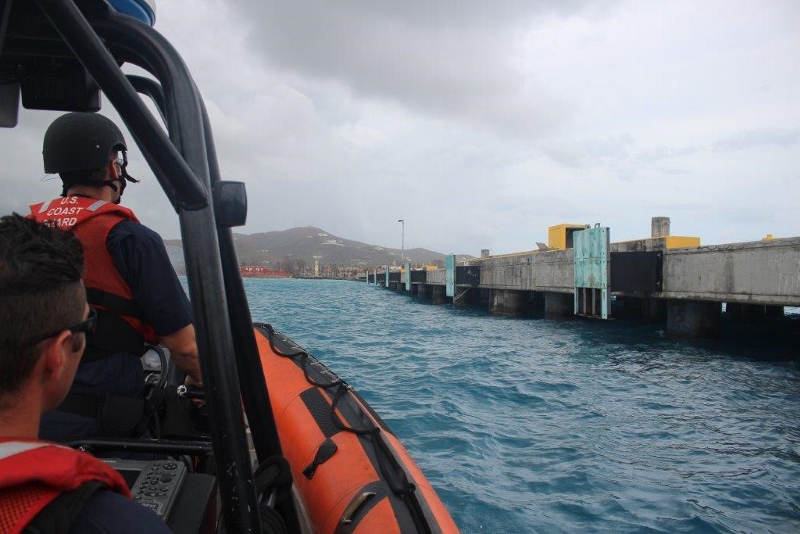Facing months without power and impending food and water shortages, reopening Puerto Rico’s ports must be a priority for recovering from Hurricane Maria, said Gov. Ricardo Rossello.
In an interview with local AM radio station WAPA Thursday, said getting ports open is critical for importing supplies, including generators. The island commonwealth of 3.4 million U.S. citizens is dependent on sea commerce in normal times for food and fuel, including fuel oil for its power plants. The Department of Homeland Security said Friday that freight vessels would arrive in Puerto Rico and the U.S. Virgin Islands.
After lashing the northern Dominican Republic, Maria was headed north with maximum sustained winds of 125 mph Friday morning. The National Hurricane Center warned of potential storm surges of 9’ to 12’ as the storm passes the Turks and Caicos Islands and southern Bahamas.
Prospects for the storm’s course in coming days pointed to a likely course midway between Bermuda and the U.S. East Coast. Forecasters said Maria could lose power as it moves over a pool of western Atlantic water cooled earlier by the passage of Hurricane Jose, now a lingering tropical system off southern New England. Like Jose, Maria will bring another week of big swells.
With at least 27 deaths from the storm, six of them in Puerto Rico, there was some good news Thursday when the Coast Guard and British Royal Navy rescued a mother and two children who survived the capsizing of the 143’x32’ Ferrel off Vieques.

The Ferrel. Photo courtesy Shipspotting.com.
A former National Oceanic and Atmospheric Administration research vessel built in 1968, the Ferrel was decommissioned in 2002 and sold by the government. It apparently had been working in the Caribbean as an inter-island ferry, according to maritime traffic tracking services.
Watchstanders at the Coast Guard Seventh District in Miami received an emergency distress radio beacon and then a radio call from the Ferrel Wednesday morning, stating the vessel was adrift in 20’ seas and 100 mph winds, with two adults and two children on board.
After losing contact the Coast Guard put out an urgent marine broadcast, and a joint U.S-British search with air and surface units began. A Coast Guard HC-130 aircraft from the Clearwater, Fla., air station located the Ferrel around 11:30 a.m. Thursday, overturned and grounded several hundred yards from a Vieques beach with the survivors on top of the hull.
An adult male who died in the capsizing was inside the vessel and could not be reached, Coast Guard officials said. A British Royal Navy helicopter crew from the 579’ auxiliary landing ship dock vessel Mounts Bay was guided to the location by the HC-130 crew, and hoisted the woman and children, taking them to the Mounts Bay.
The Federal Emergency Management Agency began operating an air bridge from Miami to Puerto Rico and the U.S. Virgin Islands Friday, with military transports flying in supplies and generators. More than 3,200 federal responders were on the ground, with more on the way like New York Task Force 1, an elite urban search and rescue team from the city with longstanding cultural ties to the island. A new and prolonged disaster sealift to the islands is inevitable, to bring in resources for clearing wreckage and the first task of restoring the Puerto Rico and USVI power grids.
The Department of Homeland Security said the airport at San Juan remained operational throughout the storm, “the result of the extraordinary actions of a small group of FAA controllers and technicians who kept systems and generators operating.” A mobile air traffic control tower and instrument landing system is being returned to St. Thomas airport and would be operational Friday, according to DHS officials.

Coast Guard air crews load an HC-130 aircraft at Miami with relief supplies for Puerto Rico. Coast Guard photo.
A Navy and Marine group led by the amphibious assault ship Kearsarge is providing air support including helicopters and V-22 Osprey tilt rotor aircraft. The 26th Marine Expeditionary Unit (MEU) is inserting air control and coordination specialists into St. Croix to help open the airfield there.
Meanwhile, FEMA has freight vessels loaded with more than 1.3 million meals, 2 million liters of water, 30 generators and 6,000 cots en route to St. Thomas, awaiting port opening and clearance. FEMA also pre-positioned commodities at its distribution center and warehouse in San Juan, including meals, water, cots, and blankets.
The crew of the Coast Guard 210’ medium endurance cutter Valiant returned to the Virgin Islands, surveying damage to harbor infrastructure at Frederiksted on St. Croix. Just days before Maria struck, St. Croix had been an operations base for relief efforts on neighboring St. Thomas and St. John, struck by Hurricane Irma two weeks before, but now needs its own recovery effort.




